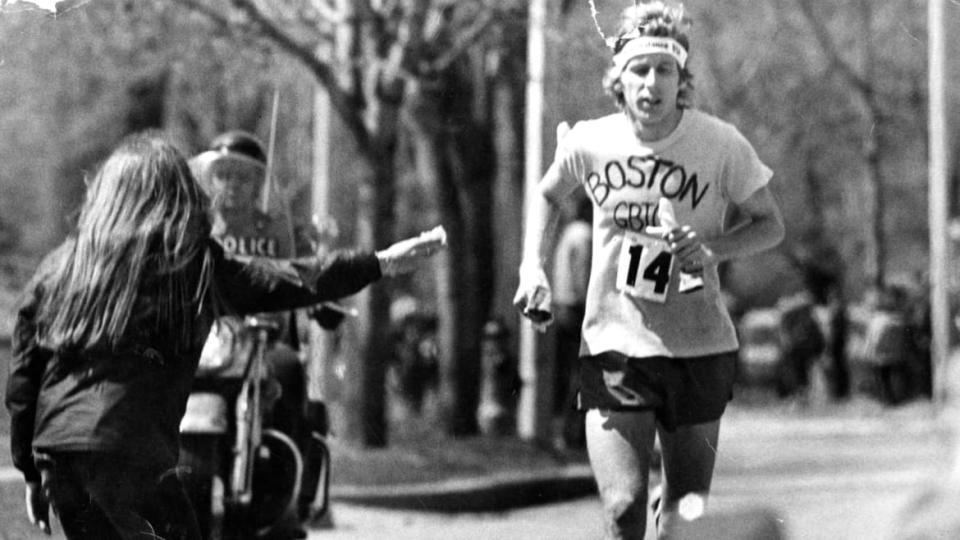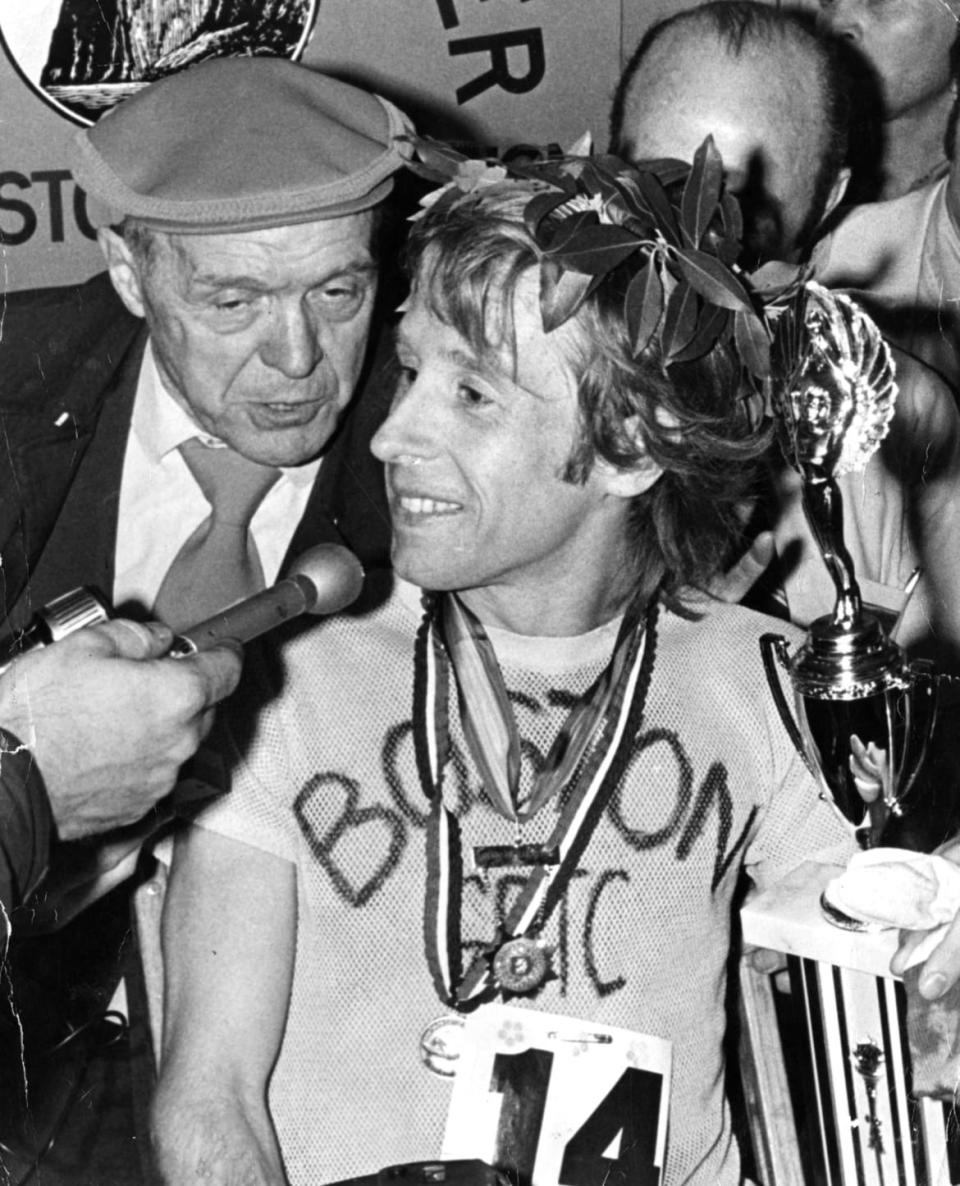Chasing the Signature Drink of Marathon Champ Bill Rodgers: The Blue Whale

This marks the debut of an occasional series in which our Senior Drinks Columnist, Dr. David Wondrich (yes, he really is a Doctor; OK, no, not that kind) takes a concise look at the history and, to coin a word, mixologistics of a particular historic cocktail—or if not historic at least old and pleasant. Why? So you’ll have something different to mix yourself this cocktail hour, that’s why.
The Blue Whale
As someone who has been publishing little histories of mixed drinks for a good 20 years, from time to time I attract random questions on the stories behind various cocktails or their evolution.
Are the Manhattan & the Martini the Same Cocktail?
Forget Sourdough Starter—You Should Pre-Batch Cocktails
Usually these are easy enough to handle: there’s either a Zombie myth I can dispel, a general origin I can add, or sometimes an inventor I can reveal. But every once in a while, though, I get a real stumper. Take, for example, this thing that Twitter user “DC_Borborgymus” tossed over the transom the other day:
“do you know anything about the regional nature of a Blue Whale being made with Vodka, instead of rum, in the Finger Lakes?”
Uuuuuhhhh—OK. This is like that thing you find among your wedding presents that you have no idea who it’s from, what it is, or even if it’s right-side up or not. Rum? Vodka? For all I knew, the damn thing—which rang no bells whatsoever—was made with Chanel No. 5, and I hadn’t been in the Finger Lakes region of New York since my cousins’ Newfoundland pulled me out of Lake Skaneateles on the off chance that I was drowning (I wasn’t). I must have been eight at the time.
I confessed my bafflement and turned my attention to other matters, at which point a sticky synapse deep in the back of my brain finally fired and flashed a picture of a pint glass full of Windex with a straw and a largish plastic whale sticking out of the top. The Blue Whale.
The Story
As far as I can recall, I never actually drank a Blue Whale, mostly because I couldn’t afford one. Back in the mid-1980s, it was something that you saw people getting ripped on if you frequented a certain subcategory of New York party bar that the Daily News characterized in 1987 as “surf bars, or places with a distinctive surf motif” and “a delirious return to the irresponsible days of summer vacation, when life really was a beach.”
For a drinker such as myself, accustomed to patronizing New York’s many fine–OK, fine-ish—old-man bars (now almost all gone, alas), these joints seemed fancy. They were not. If that weeklong rental in the Hamptons, when you and 11 of your other mostly-broke college buddies shared a two-bedroom cottage three blocks from the beach, didn’t give you enough hangovers and regrets, places like Lucy’s Surfeteria and The Big Kahuna were there to fill the deficit. Now (getting back to the matter at hand), it’s true that these bars used vodka in their Blue Whales, at least according to the Daily News. But given their relation to authenticity, however you define it, perversely that makes me more likely to believe that the Blue Whale was originally a rum drink. My wife used to work at Caramba! at the time, which was to Mexico as the surf bars were to Malibu, and they used to make their famous Frozen Margaritas not with tequila, but with Everclear smuggled in from Jersey (it was illegal in New York at the time).
But no, the original Blue Whale was not a rum drink, as an hour of poking through various newspaper archives handily proved (OK, my curiosity got woken up, plus ADD). The Blue Whale, it turns out, carved out a small but distinguished place in the Annals of American Sport, and it did it with vodka. You see, it was Bill Rodgers’ signature drink, and if ever there was an American entitled to be called a living legend, it’s Bill Rodgers. Olympian, 22-time marathon winner (including the New York Marathon four years in a row and the Boston Marathon four times in five years), on and on. In 1978, he won 27 of his 30 races (including both of those marathons).
But when Rodgers entered the Boston Marathon in April, 1975, nobody paid much attention. Sure, the 27-year-old Boston College grad student had won a couple of other marathons, but they were pretty low-profile and he was just another face in the crowd.

Then he won the damn thing, in record time, and even stopped a few times to drink water along the way—he couldn’t drink while running, you see. But he could drink while standing, and that night, after shaking the reporters to go home for a shower and a nap and then a quick drink at the Colonnade Hotel with some fellow runners, he headed to the Eliot Lounge, on the ground floor of the Eliot Hotel at the corner of Massachusetts Avenue and Commonwealth Avenue, and did just that.
The Eliot was Boston’s runners bar, at a time when running was still an amateur sport that was only just emerging from its insurgent, underground stage and garnering mainstream attention. With marathoner Tommy “Rainbow” Leonard behind the bar, the place was a shrine to running and runners, and the unofficial headquarters of the Greater Boston Track Club, whom Rodgers represented that day, and it was a scene.
Like a great many big-city hotel bars at the time, the Eliot was as much dive as it was respectable hotel bar. I mean, somebody brought a horse in there once. But that night—April 21, 1975—they had actual Champagne on ice. When Rodgers walked into the bar he found a lot of people waiting for him. They cheered and popped it open. “I had free Champagne,” he told the man from the Boston Globe, “I don’t usually have free Champagne.”
But Rodgers also had something else: Leonard handed him a thing he called the “Blue Whale.”
“I don’t even know what was in it,” the champ admitted. “It looked like Windex.”
The Globe reporter, Joe Concannon, being a man who knew his business, he called Tommy Leonard and asked him. It was just a “vodka Collins, with blue curaçao,” Leonard admitted. No matter; before long the Blue Whale became Rodgers’ signature drink, and by the end of the decade it escaped into the wild.
There, things happened to it: some made it as a shooter, others—well, we’ve seen the plastic whale. By 1990, some were even making it with rum, even if it was of the white commodity style that’s almost indistinguishable from vodka. Eventually, pineapple juice and peach schnapps crept into the thing, at which point Tommy Leonard’s simple Collins variation seemed as quaint as Patti Page singing the “Tennessee Waltz.” And yet, there are still some parts of the country where they hold the line. As our Twitter friend DC_Borborgymus wrote in a follow-up tweet,
“I’ve started at a new restaurant that had its cocktail menu designed by a well intentioned consultant who had heard of the prevalence of blue whales in this area. He put the original [i.e., rum] recipe on, but I’ve had tons of locals upset that the recipe is ‘wrong.’”
The Mixology
Admittedly, a Vodka Collins with a splash of blue curaçao isn’t the most exciting drink in the world. But in the heat and humidity of summer, it’s pretty damn refreshing and the blue makes it seem even more so than it is. The original formula seems to have been equal parts vodka, curaçao and sour mix, in a tall glass with ice and soda. That’s fine for the 1970s, but there are things we can do to improve it without verging into fussiness or weirdness.

One of them is to embrace the white rum idea, but use something with a little flavor, such as Banks, Denizen or Hamilton White ‘Stache brands, if you can find them. With a drink this forgiving, you can even go so far as using a rhum agricole from Martinique or one of the funky Mexican rums that are starting to be imported (the blue-bottle Uruapan is particularly fine here). I’d skip the pineapple juice, though, and stick with lemon juice over lime. The essence of the drink is to be lean and clean, not sweet and fruity. Oh, and for the curaçao, if there’s any way you can get the Senior brand, that’s actually made in Curaçao, do that. If not, Giffard or, really, any other imported brand will give you better results than the bottom-shelf stuff made here. I wish it were otherwise, but it ain’t.
(If you’d rather stick with vodka, I like this best as a shooter: build as below, but when you’re done shaking it, strain it into two tall shot glasses and forget the rocks and the seltzer. If you must, you can give one of the shooters to a friend.)
INGREDIENTS
2 oz Flavorful white rum or vodka
.75 oz Imported blue curaçao
.75 oz Lemon juice
1 teaspoon Sugar
2-3 oz Sparkling water, chilled
Glass: Collins
Garnish:1 Toy whale, cocktail-sized (optional)
DIRECTIONS
Add the lemon juice and sugar to a shaker and stir. Add the rum or vodka and curaçao.
Add 3 to 4 ice cubes to a Collins glass and add an ounce or so of sparkling water.
Fill the shaker with ice and shake. Strain into the prepared glass and top off with another ounce or so of the sparkling water.
Add a (paper) straw, and, of course, the whale. Raise a glass to Bill Rodgers.
Get our top stories in your inbox every day. Sign up now!
Daily Beast Membership: Beast Inside goes deeper on the stories that matter to you. Learn more.

